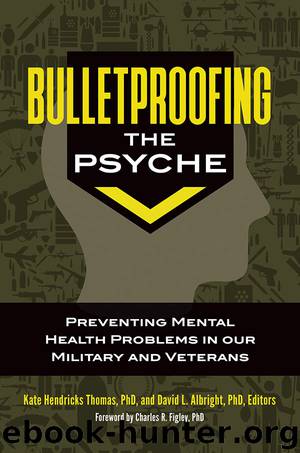Bulletproofing the Psyche by Kate Hendricks Thomas Ph.D

Author:Kate Hendricks Thomas Ph.D.
Language: eng
Format: epub
Publisher: ABC-CLIO
Published: 2018-04-03T16:00:00+00:00
What Is Resilience?
There are two closely related concepts in the study of people’s ability to bounce back, grow, and even thrive in the face of adversity. Resilience is characterized as a dynamic trait that allows a person to return to their baseline functioning after a traumatic event (Herrick, Stall, Goldhammer, Egan, & Mayer, 2014). Resilience can mediate the effects of stigma, prejudice, violence, and harassment on LGBT people (Frost & Meyer, 2015). The second is posttraumatic growth (PTG), a concept developed in response to individuals’ ability to grow after coping with trauma (Calhoun, Cann, & Tedeschi, 2000; Calhoun & Tedeschi, 1999). Many argue that because research is problem- focused, clinical practice is hindered (Kwon, 2013). This focus also perpetuates stereotypes of LGBT people as sick and pathological (McWhorter, 1999).
PTG is described in LGBT populations. Literature examining stress-related growth (SRG) in LGBT people suggests that growth is often coupled with social consciousness and activism (Bonet, Wells, & Parsons, 2007; Riggle, Whitman, Olson, Rostosky, & Strong, 2008). One study notes several themes related to the positive aspects of identity. Choosing new and supportive families, serving as role models, and involvement in activism and promoting social justice were all intricately related to identity as sexual minorities (Riggle et al., 2009). Similar concepts were established in a study where SRG was associated with lesbian women’s intentions to prepare the way for a new generation as was involvement with activism in the LGBT community. Of note is the finding that lesbians of color reported higher levels of SRG than white women, despite the racism they face in addition to homophobia (Bonet et al., 2007). In terms of older transgender veterans, one study found military service is associated with greater resilience and positive mental health outcomes among veterans as compared to transgender civilian older adults (Hoy-Ellis et al., 2017).
While research suggests that individual traits can foster resilience (Elliott et al., 2015; Southwick, 2012), one must exercise caution when examining resilience in oppressed and marginalized populations such as those who identify as LGBT. When examining resilience, we cannot categorize individuals as either resilient or not resilient (Meyer, 2015). This can devolve into victim blaming. Instead, we should focus on both individual and communal resources and structural inequality and barriers (Meyer, 2015).
An essential component to resilience is community and social support (Elliott et al., 2015; Southwick, 2012). A sense of belonging has been found to mitigate postdeployment depression in military personnel (Bryan & Heron, 2015) and bolster resilience among injured veterans (Eakman, Schelly, & Henry, 2016). Community-level resilience for LGBT populations can take many forms, including presence of positive role models and a sense of belonging (Kwon, 2013). Community support and belonging have also been found to mitigate the effects of LGBT-related violence and harassment in nonmilitary populations (Meyer, 2015).
LGBT veterans offer numerous examples of resilience. Under military service bans, LGBT service members organized underground support networks; enacted everyday forms of strength, resistance, and resilience in response to the bans; advocated for social change in the military and
Download
This site does not store any files on its server. We only index and link to content provided by other sites. Please contact the content providers to delete copyright contents if any and email us, we'll remove relevant links or contents immediately.
Should I Stay or Should I Go? by Ramani Durvasula(6816)
Why We Sleep: Unlocking the Power of Sleep and Dreams by Matthew Walker(5674)
Fear by Osho(4101)
Flow by Mihaly Csikszentmihalyi(4072)
Rising Strong by Brene Brown(3795)
Why We Sleep by Matthew Walker(3790)
Too Much and Not the Mood by Durga Chew-Bose(3705)
How to Change Your Mind by Michael Pollan(3693)
The Hacking of the American Mind by Robert H. Lustig(3592)
Lost Connections by Johann Hari(3462)
He's Just Not That Into You by Greg Behrendt & Liz Tuccillo(3320)
Evolve Your Brain by Joe Dispenza(3066)
What If This Were Enough? by Heather Havrilesky(2951)
Resisting Happiness by Matthew Kelly(2896)
Crazy Is My Superpower by A.J. Mendez Brooks(2873)
The Courage to Be Disliked by Ichiro Kishimi & Fumitake Koga(2816)
The Book of Human Emotions by Tiffany Watt Smith(2783)
Descartes' Error by Antonio Damasio(2753)
In Cold Blood by Truman Capote(2697)
